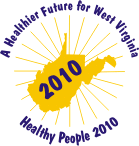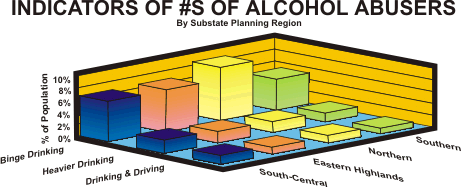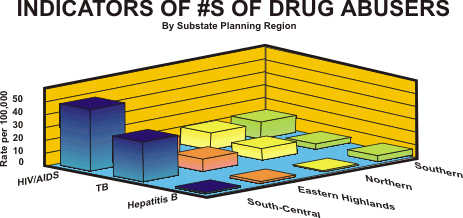A Healthier Future for West Virginia - Healthy People 2010
Federal 2010 Initiative
|
Contents Message Credits Introduction Objectives |
|
| 1 2 3 4 5 6 7 8 9 10 11 12 13 14 15 |
16 17 18 19 20 21 22 23 24 25 26 27 28 29 |

26 - Substance Abuse
Background
Substance abuse is a personal tragedy, causing untold pain to individuals and their families. Untreated substance abuse can lead to loss of jobs, loss of families, and, ultimately, to loss of life.
In addition to the individual costs, there is an enormous cost to society. Lost work force productivity due to substance abuse costs the nation at least $14 billion annually in unemployment, impairment, absenteeism, medical costs, and premature deaths. Crime related to substance abuse costs the nation an estimated $57 billion per year, not including the medical costs of victims and law officers.
Yet treatment works. A variety of studies show that treatment reduces use by 50% to 60%. Treatment increases the likelihood of employment by 40% or more. Addicts who undergo treatment are 40% less likely to be arrested. Addicts who receive appropriate treatment while in prison are 73% less likely to be re-arrested and 44% less likely to return to drug use than are untreated inmates. Every $1 invested in substance abuse treatment yields a return of $4 to $7 in reduced crime and criminal justice costs. Drug abuse treatment reduces injection users' risk of spreading HIV and other infections by as much as 60%, and abstaining addicts do not generate expensive emergency room treatment. Treatment reduces crime; for example, the number of drug-related murders has hit the lowest point in more than a decade -- down from 1,402 in 1980 to 786 in 1997.
In West Virginia, approximately $18,800,000 is spent annually on substance abuse treatment and related services. This includes $6,400,000 in federal funds, $5,800,000 in state funds, and $6,600,000 in Medicaid funds. The Division on Alcoholism and Drug Abuse has been designated by the legislature as the lead agency for the prevention and treatment of substance abuse. The Division has also been designated by the federal government as the Single State Agency for substance abuse. As such, it is the recipient of the Substance Abuse Prevention and Treatment Block Grant, which provides the majority of the federal funds available for substance abuse treatment and prevention.
During state fiscal year 1998-99, the Division provided funding to treat 18,854 persons for substance abuse. Almost 79% of these were treated for alcohol abuse/addiction, and slightly over 21% for other drugs. Of the latter number, almost 1,900 were injecting drug abusers. Outside of alcohol, the primary drugs of choice were marijuana, 1,795; crack, 605; non-heroin opiates and synthetics, 553; other cocaine, 342; and heroin, 138.
Males represented 77% of those treated and females 23%. One hundred thirty-six (136) of the females were pregnant at the time of admission to treatment. The large majority (70%) were 25-54 years of age. Unfortunately, 1,500 were under the age of 18. Of those treated, 5,600 received public inebriate services; 2,070 were treated in a short-term residential setting; 1,300 were treated in a long-term residential setting; and the remainder received various outpatient services.
Adolescents who use alcohol and other drugs are much more likely than their non-using peers to experience other serious problems. An estimated one in four adolescents is at risk of alcohol and other drug problems, school failure/drop-out, teen pregnancy, delinquency, and/or suicide. Research has shown that the earlier a child uses alcohol or other drugs, the more likely she/he is to come to harm. Youth under 15 who use drugs are twice as likely to become dependent on the drugs than are youth 15 and over.
Just as treatment works, so does prevention. According to the National Household Survey on Drug Abuse, overall drug use among youth declined 13% in 1998. More parents report that they talk to their children about drugs, and youth report that these conversations have helped them reject substance abuse. A massive media campaign, the "National Youth Anti-Drug Media Campaign," has been launched to counteract the effects of advertising and provide honest information about the impact of drugs. These messages are already changing young people's attitudes about drugs.
There are scientifically validated risk factors that predispose a child to substance abuse or other problems. Similarly, there are certain resiliency factors that help protect a child from negative influences. Successful prevention programs are designed to minimize risk factors and to strengthen resiliency factors. It has been estimated that for every $1 spent on scientifically based prevention programs $7 are saved in treatment and other costs to society.
Assessment of Need. An assessment of need is integral in determining the demand for treatment and the need for targeted prevention. In evaluating progress, it is necessary to first determine a baseline.
A federally funded needs assessment completed in 1997 indicated that there were approximately 40,000 adults in West Virginia needing treatment for substance abuse. The 1995 Youth Risk Behavior Survey (YRBS) conducted by the Department of Education indicated that 81% of students surveyed had used alcohol, with 52% having used it in the previous month. Twenty-eight percent (28%) reported that they had their first drink at the age of 13. Similarly, 43% reported smoking marijuana at least once, with 26% having used within the last month. Twenty-five percent (25%) of the students had first tried marijuana at 14 or younger. Although a needs assessment has not been conducted of youth, extrapolated data indicate that approximately 25,000 youth in grades 6 to 12 (16%) may be in need of treatment for substance abuse.
These studies were conducted on a statewide basis, with none providing
data on a regional basis. The Division does have selected data on drug
and alcohol abuse available by region, however, shown below for the four
designated Substate Planning Regions (SSP) – Southern, Northern,
Eastern Highlands, and South-Central.


To be more accessible to the population, and to facilitate continuity of care, the need for treatment programs should be determined in each SSP. Prevention programs should be as localized as possible, so that community-based prevention needs can be addressed, and cultural factors taken into account.
To determine the need for developing or modifying programs, a more thorough
assessment must be conducted, using indirect indicators to determine treatment
and prevention needs. To determine effectiveness of programs, baseline
data must be available, preferably on a county level, but at least on
the SSP level. Some indicators of the need for treatment are already collected
by other agencies, and are available on the SSP level. Some of the available
indicators of the need for treatment for alcohol abuse are the percent
of the population who binge drink; the percent who engage in heavier drinking;
and the percent who drink and drive. This information is collected monthly
through the Behavioral Risk Factor Surveillance System (BRFSS) survey
conducted by the Health Statistics Center of the Bureau for Public Health.
The rates of HIV/AIDS, tuberculosis, and Hepatitis B can be considered
indicative of the demand for drug abuse treatment. As can be seen in the
accompanying two charts on the previous page, it appears that the need
for alcohol abuse treatment is greatest in the Northern and the South-Central
SSPs, and the need for drug abuse treatment the greatest in the South-Central
SSP.
Although the available data give some information about the relative need
for treatment, they do not address issues such as numbers of people in
need of treatment, types of treatment needed, or special populations needing
treatment such as pregnant women or adolescents. This information is not
available and is vitally needed in planning the most effective distribution
of scarce treatment resources.
Similarly, there is insufficient information available on the presence or absence of risk and protective factors to allow the Division to re-focus prevention programming on areas of greatest need, either in terms of geographical location or in terms of specific populations.
The Objectives
FLAGSHIP OBJECTIVE
OBJECTIVE 26.1. (Developmental) Increase the number of persons who receive residential and outpatient treatment according to their needs by 5% for adults 18 and older and by 2% for adolescents. (Baseline data available in 2002)
Data Sources: West Virginia UB-92 hospital discharge database for inpatient services; data source for outpatient services to be developed
OBJECTIVE 26.2. Increase the number of high-school-aged youth who have never tried alcohol to 35%. (Baseline: 28.8% in 1997)
Data Source: West Virginia Department of Education (WVDOE), Office of Healthy Schools (OHS), Youth Risk Behavior Survey (YRBS)
OBJECTIVE 26.3. Increase the number of high-school-aged youth who have never tried cocaine to 94%. (Baseline: 90.5% in 1997)
Data Source: WVDOE, OHS, YRBS
OBJECTIVE 26.4. Increase the number of high-school-aged youth who have never tried marijuana to 60.1%. (Baseline: 52.3% in 1997)
Data Source: WVDOE, OHS, YRBS
OBJECTIVE 26.5. Reduce deaths and injuries caused by alcohol-related motor vehicle crashes by 20%. (Baselines: 144 in 1998; 145 in 1999)
Data Source: West Virginia State Police, Fatal Accident Reporting System (FARS)
OBJECTIVE 26.6. Reduce deaths due to cirrhosis of the liver to less than 7.5 per 100,000 population. (Baseline: 10.7 in 1998)
Data Source: West Virginia Bureau for Public Health (WVBPH), Office of Epidemiology and Health Promotion (OEHP), Health Statistics Center (HSC)
OBJECTIVE 26.7. Reduce the proportion of adolescents who report that during the previous 30 days they had ridden with a driver who had been drinking alcohol. (Baseline: 35% in 1997)
Data Source: WVDOE, OHS, YRBS
OBJECTIVE 26.8. Reduce the rate of adults 18 and older who reported driving "after having had perhaps too much to drink" at least once during the past month by 20%. (Baseline: 0.08% in 1997)
Data Source: WVBPH, OEHP, BRFSS
OBJECTIVE 26.9. Reduce the rate of heavier drinking reported among adults 18 and older (heavier drinking defined as 60 or more drinks per month) by 20% . (Baseline: 2.1% in 1997)
Data Source: WVBPH, OEHP, BRFSS
OBJECTIVE 26.10. Reduce the rate of binge drinking reported among adults 18 and older (binge drinking defined as 5 or more drinks on any one occasion in the past month) by 20%. (Baseline: 8.4% in 1997)
Data Source: WVBPH, OEHP, BRFSS
OBJECTIVE 26.11. Extend legal requirements for maximum blood alcohol concentration levels to be reduced to 0.08. (Baseline: 0.10 in 2000)
Data Source: West Virginia State Code, Motor Vehicles
Meeting the Objectives
Health Promotion Channels for Achieving Objectives:
- Worksites
- Schools
- Public Health Programs
- Networks
- Health Care System
- Higher Education
Some of the organizations that will be leading the initiatives to reach the objectives include:
- Office of Behavioral Health Services, Division on Alcoholism and Drug Abuse, WVBPH
- Fourteen regional behavioral health centers West Virginia Division of
- Criminal Justice Services
- West Virginia Department of Education
- West Virginia University Prevention Resource Center
- Governor's Cabinet on Children and Families
Drug and alcohol abuse can affect every facet of our society. Due to factors such as stigmatism and enabling codependents, this type of illness can be difficult to detect. For this and many other reasons, the above mentioned collaborators will need to effectively combine their efforts to bring about positive changes in the current drug and alcohol abuse statistics.
Work Group Members
Mary Pesetsky, MPH, Work Group Leader, Substance Abuse Program,
Office of Behavioral Health Services, WVBPH
Helena Lee, Drug-Free Communities Specialist
Lynn Evans, Prevention Network Coordinator
c/o Division on Alcoholism and Drug Abuse, WVBPH
Shawn Cade, Consultant for Adolescent Services, Division on Alcoholism
and Drug Abuse, WVBPH
Terri Cunningham, Substance Abuse Coordinator, United Summit Center
Leslie Reedy, Substance Abuse Coordinator,
Northwood Health Systems
Yvonne Katz, Research Evaluation Specialist, Marshall University
Graduate College
Larry Belcher, Executive Director, WV Mental Health Consumers Association
Amy Carte, Executive Director, State Health Education Council
References/Resources
West Virginia Office of Healthy Schools. Unpublished data from the 1997 Youth Risk Behavior Survey. Charleston, WV: West Virginia Department of Education.
West Virginia State Police. FARS data.
West Virginia Bureau for Public Health. Behavioral Risk Factor Survey 1997. Charleston, WV: West Virginia Department of Health and Human Resources, 1998.
United States Department of Health and Human Services, Substance Abuse and Mental Health Services Administration. National Household Survey on Drug Abuse, 1999.
For More Information
Substance Abuse Program
Office of Behavioral Health Services
350 Capitol Street, Room 350
Charleston, WV 25301-3702
Phone: (304) 558-2276; Fax: (304) 558-1008
This page was last updated June 28, 2001.
For additional information about HP2010, contact Chuck Thayer at (304) 558-0644
or Chuck.E.Thayer@wv.gov